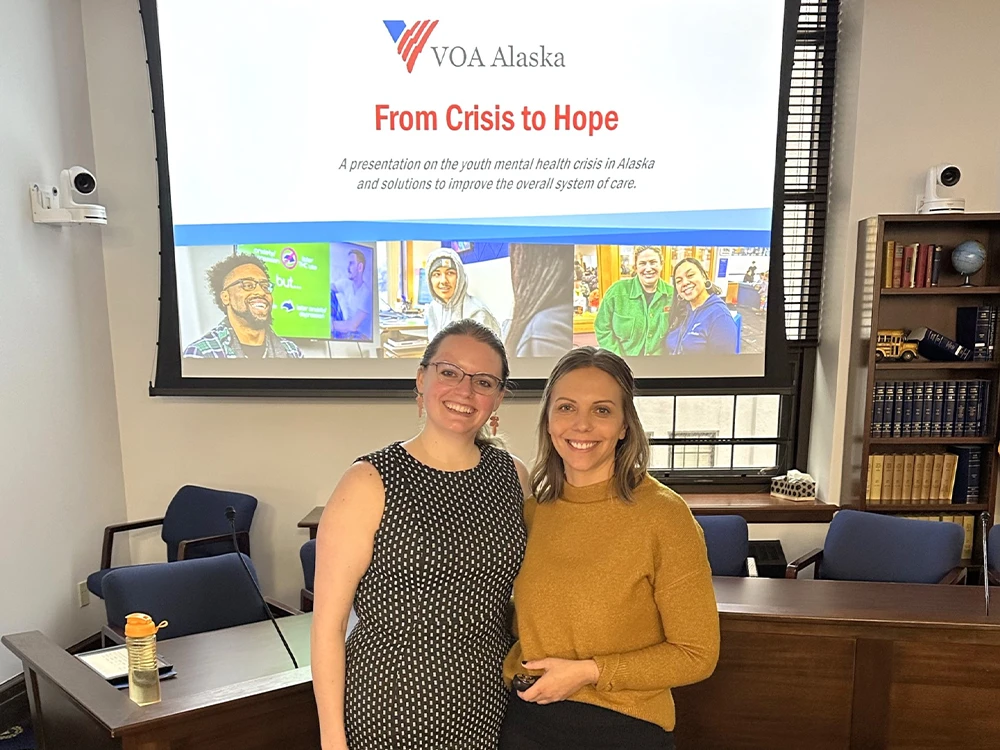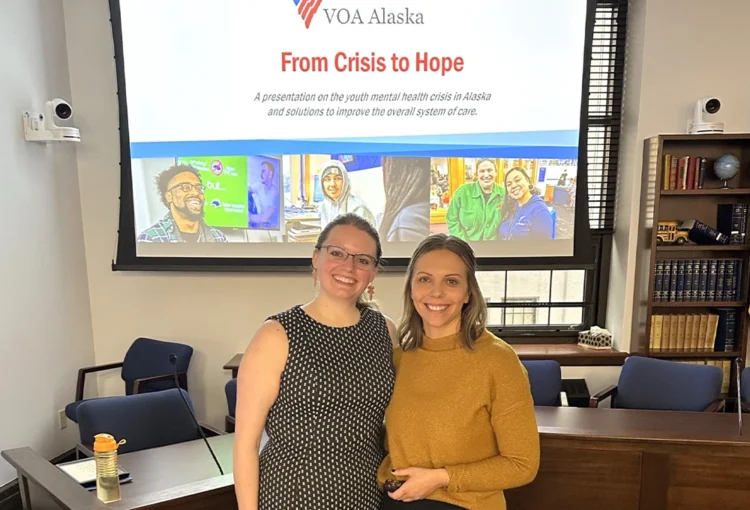What do popping bubbles, drawing pictures, burning letters, and reading Harry Potter all have in common? They are just some of the creative ways the VOA Alaska team guides youth and young adults toward building healthy coping skills and overcoming challenges.
Therapy looks different for everyone, and the innovative interventions below help youth express, discuss, and understand their thoughts and feelings in a safe and supportive environment.
1. Popping Your Burdens with Bubbles
How It Works: This one is deceptively simple. You are given a wand and instructed that the bigger the bubble you blow, the bigger the burden that you are (figuratively) releasing. The key here is having patience, blowing slowly, watching the bubble grow, and being intentional about when it pops.
Why It’s Effective: The bubble is a visual representation of allowing yourself to be free of burdens, no matter the size. The small burdens can be released quickly with little effort. But the more complex the burden (the bigger the bubble) the more time and dedication it takes to remove it from your life.
Its Impact: Two youth that recently took part in the activity shared how helpful it was for expressing their burdens out loud. One learned how she had to be “mindful and patient” as the bubble/burden grew larger. Another shared that he felt frustrated when he tried to rush popping the burden but felt accomplished as he took his time and was able to blow and release a large bubble.

2. Drawing Your Feelings Where You Feel Them
How It Works: Draw an outline of your body on a piece of paper. Pick an emotion that you are feeling now or feel often. Then find where you feel that feeling in your body, such as in your chest, stomach, head, hands, or feet. Draw what that feeling looks like and try to be as visually detailed as possible. What color is it? How big is it? What shape is it? The final step is discussing what you drew with your clinician.
Why It’s Effective: By drawing your feelings, you’re able to increase your emotional awareness—specifically how you experience those emotions. Discovering how these emotions manifest in your body can help you learn and practice new coping skills that target that feeling, and the source of those feelings, more effectively.
Its Impact: After a youth completed this activity with their clinician, they found it surprising to realize just how they were experiencing anxiety. They had never conceptualized it in such a way before. It helped them compare the differences between each emotion, and then connect the coping skills they could apply for each one. Drawing their feelings where they felt them increased their emotional awareness and package it in a way that wasn’t as overwhelming and unknown as it had felt before.
3. Telling Your Story Through the Story of Harry Potter
How It Works: This therapy technique can work with any story, be it a book, movie, even a video game. There just happen to be a lot of Harry Potter fans at VOA Alaska. The key is finding a character (or maybe a few) that you identify with. Share with your clinician how that character’s story is like yours. If that character was dealing with the same situations that you are, how would they react?
Why It’s Effective: It’s often difficult to put into words what you are feeling, especially when you’re trying to process trauma, stress, and anxiety. Seeing yourself, and putting yourself, in a story you love provides a template for framing your story and offering inspiration. When your clinician also knows the story, it’s an effective starting point for beginning those challenging conversations.
Its Impact: One youth identified with both Harry Potter and Draco Malfoy. In Harry, she identified with him being an outcast while living with his relatives. In Draco, it was because everyone took his fathers side and didn’t stop the bad things that were happening. Through several sessions, she used their stories to reduce the overwhelming complexity of her own story and became more comfortable sharing her feelings. Now, she’s more open with her clinician, processing her thoughts and feelings easier, and choosing to make positive choices.


4. Discovering the Mask You Wear For Others
How It Works: You’re given a paper with the outline of a face on the front and back, along with colored pencils. You begin by writing or drawing the thoughts and emotions that you show the world. Then flip the paper over and write or draw the thoughts and emotions that you don’t show anyone, the ones you hide and internalize.
Why It’s Effective: With this activity, you’re exploring the mask you put on when interacting with the world and learning how those contrast with who you are under that mask. This incongruity is often a major factor in persisting mental health symptoms. By writing or drawing these feelings and visualizing them as a double-side mask you are wearing, it’s easier to express and process with your clinician.
Its Impact: Through this activity, one youth realized how much they put on “fake happy emotions” for others. They identified that were not comfortable sharing their true feelings with the world and unsure of who they wanted to be. It led to discussions of identity with their clinician, and it helped increase their awareness of emotions, cope with the uncertainty, and have it not all seem so overwhelming.
5. Writing Letters, and Burning Them, to find Closure in Incomplete Relationships
How It Works: Incomplete relationships are those in which something is missing, and you may feel regret, sorrow, or pain. In this intervention, you address a letter directly to the person on the other side of this relationship and describe how what they’ve done has hurt you. You close with an impact statement, choosing a phrase such as “I forgive you,” or “I’m letting it go.” After you read the letter out loud to your clinician, you’ll set the letter on fire and watch it burn.
Why It’s Effective: Sometimes it’s difficult to understand or put into words how toxic relationships influence our lives, thoughts, and feelings. By addressing the people that have hurt you in a letter, you apply emotions and words to what has occurred, and practice healing and forgiveness rather than anger and resentment. Burning the letter, instead of tossing it in the trash, provides a symbolic sense of release and permanency to the thoughts and feelings you’ve expressed.
Its Impact: A youth had a close friend completely cut ties with her. She was grieving the loss of this friend and had so much she wanted to tell her. She addressed the letter to her friend and wrote everything out that she wanted to say. When she burned the letter, she said she felt like a weight was lifted. She still thinks about her, but she no longer has those heavy negative thoughts burdening her.
VOA Alaska’s integrated behavioral health and wellness services create a safe space for youth to find hope and healing. We believe in the power of human connection and are guided by our values to support the youth and families who engage in our services.











